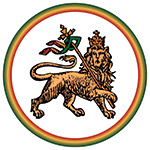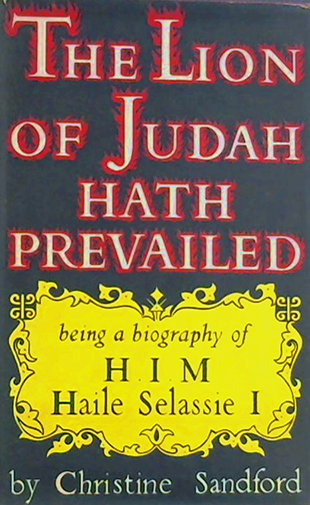THE LION OF JUDAH HATH PREVAILED
15
The Next Ten Years
3. Security Forces
Ethiopia to-day is at peace. Public security reigns on the highways and byways of the empire. The Emperor has at his disposal a small but well-trained and adequately equipped army, and an efficient police force, capable of dealing with all foreseeable emergencies. Surely a cause for thankfulness in an uneasy world!
That this happy state of affairs would be achieved so comparatively quickly could certainly not have been taken for granted in early 1942, when the last of the British troops were withdrawn and Haile Selassie was left to face his responsibilities alone. The state of chaos within his country has already been described. It must be remembered too that the world was still at war—desperately at war—with the critical days after the fall of Singapore, and the struggle in the Western Desert, still to come. It was impossible to find equipment other than that available from the defeated enemy. Men’s thoughts and energies were turned elsewhere in the common struggle for existence. Yet there were many problems for the Emperor to face in his own country and many question marks as to the future on his frontiers, all requiring—for the safety of his country and the peace of his own mind—that he should have the force at his back to ensure law and order at home and respect abroad.
It was under these circumstances, and with these limitations, that the Emperor set to work to plan the formation and organization of his security forces—the Regular Army, the Imperial Bodyguard (which has always been the prerogative of the King of Kings of Ethiopia), and the police.
The reorganization of the army was undertaken with the help —under the terms of the Agreement signed between Great Britain and Ethiopia in January 1942—of a British Military Mission composed of officers and non-commissioned officers. It was decided that at first the task should be dealt with by two separate administrations. The formation, training, and administration of the new Regular Army was to be the business of the British Military Mission and carried out under their control; and the maintenance and administration of the existing troops, so to speak the ‘irregular’ army composed largely of patriots and formations raised hastily during the recent campaign, was to be under the direct control of the Ministry of War. This ‘irregular’ army was partly trained, and was to be employed on the important and essential task of maintaining internal security whilst the Regular Army was being formed and trained. This practical arrangement worked very well until in August 1944 the ‘irregular’ was assimilated into the Regular Army, the whole becoming the Imperial Army under the Imperial Ethiopian Ministry of War. During the next two years trained Ethiopian officers took over all the posts of command and administration from the British officers, these latter continuing in the position of advisers and inspectors or instructors until the British Military Mission was withdrawn in 1951.
The Imperial Army is organized after the British model in three divisions with their peace-time headquarters at Addis Ababa, Harar, and Dessie; and there is the usual subdivision into brigades and battalions disposed about the country at suitable points. There is artillery, an Armoured Corps (recently equipped with more modern tanks), a Signal Corps, a Corps of Engineers, and an Army Service Corps; and the usual auxiliary services. A special feature of the Signal Corps is that it is mainly recruited from orphan boys and children of soldiers, who are given a good education and strict training and are mustered as signallers when they become of age.
The Haile Selassie I Military Training College at Gannet, twenty-five miles west of Addis Ababa, is a very important part of the army’s organization. It was first opened in 1932 under Swedish instructors; and during the Italian invasion most of the young cadets were killed in the fighting. It was reopened in 1942 for cadets who had already begun courses of instruction in Khartoum. The college, until the British Military Mission was withdrawn, was under their control. Over 2,000 officers have graduated from the fourteen cadet courses which have been held. Instructional and administrative courses are also held there for subaltern officers recommended by their unit commanders, as also senior officers’ courses and staff courses.
Recently the army has been receiving military equipment of all sorts from the United States; and in accordance with an agreement made between the United States and Ethiopia in October 1953 an American Military Assistance Advisory Group is now in the country for the purpose of training the Army in the use of these most up-to-date weapons.
The training of the Imperial Bodyguard, a corps d’elite of some 5,000 men, has been carried out by officers of the Swedish Army. The bearing of these men on parade—and of course they take part on many ceremonial occasions—is very fine indeed; and the efficiency of their training has been proved in war. For the Emperor, jumping at all opportunities to give practical aid to the causes of the United Nations, has maintained at full strength for the past four years a battalion in Korea. The rank and file of this unit have been mostly furnished by the Imperial Bodyguard, but the officers have been drawn from the Imperial Army as well as from the Guard. These troops have done extremely well and have won golden opinions from the American commanders under whom they have served. It must have been with peculiar pride and pleasure that the Emperor read the following citations. The first is a Distinguished Unit Citation dated 12th December 1952:
The First Kagnew Battalion, Imperial Ethiopian Expeditionary Force to Korea, is cited for outstanding performance of duty and extraordinary heroism in action against the enemy in the vicinity of Sam-Hyon, Korea, during the period of 16th September to 22nd September 1951. Throughout the day and night of 16th September, the battalion, occupying defensive positions in close proximity to a large hostile force, dispatched a series of probing patrols in an effort to gather information as to the disposition of the enemy. Several contacts were made.... Finally an enemy force was observed preparing positions on the slope of a commanding terrain feature, and the battalion immediately sent two reinforced squads to assault the hill. Fighting with great determination, the friendly troops battled their way up the slope and drove the enemy from their positions with heavy casualties. With the objective secured, observers, utilizing their new vantage point, discovered feverish enemy activity on adjacent slopes and called for an air strike and artillery and mortar fire. After the initial bombardment, assaulting elements of the battalion hit the positions in a whirlwind attack, engaged the foe in hand-to-hand combat, and inflicted exceptionally heavy casualties upon the enemy.... The Kegnew Battalion... displayed such superlative effectiveness in accomplishing its mission as to set it apart and above other units participating in the action. The extraordinary heroism, determination of purpose, and magnificent fighting spirit of the members of this battalion reflect great credit on themselves and are in keeping with the most esteemed traditions of the military profession.
The second Distinguished Unit Citation is dated 26th June 1954:
The Third Kagnew Battalion, Ethiopian Expeditionary Forces to Korea, is cited for outstanding performance of duty and extraordinary heroism in action against the enemy in the vicinity of Tokan-Ni, Korea, on 20th May 1953. Following an intense mortar and artillery barrage which had sealed supply and reinforcement routes, the enemy launched a furious reinforced attack against two friendly outposts and the battalion’s forward positions on the main line of resistance. The superior numbers of the attacking force would have impelled a lesser defender to withdraw to positions along a secondary line of defence; however, the battalion troops rallied with a magnificent surge of spirit and heroic determination to hold the assigned sector at any cost. The battalion called for the fire of their supporting artillery on the besieged first outpost and the men defending that position left their bunkers and moved through their own barrage to hurl the enemy from the outpost at bayonet point. This same procedure was followed by the second outpost and they too were successful in forcing the enemy to retreat. Meanwhile the hostile force hurled wave after wave against the main line of resistance in their attempt to overrun the battalion position but each time the defenders unhesitatingly raced from their positions to grapple with the enemy in hand-to-hand combat and, after exacting extremely heavy casualties, forced them to retreat. Due to the unwavering courage of the officers and men of the battalion every thrust of the enemy attack was repulsed and the entire invading force was decisively routed.... The superb esprit de corps and extraordinary heroism displayed by the members of this unit reflect great credit on themselves, their organization, and the Ethiopian Army.
No one can say that the new-model Ethiopian Army has not begun well.
The internal security of the country is primarily the responsibility of the Minister of the Interior, to whom in turn each Governor-General of a province is responsible for the maintenance of security in his own province. To enable them to carry out their responsibilities there is a centrally organized and administered State Police Force numbering some 24,000 officers and men, under the command of a Commissioner of Police. This large force has of course been gradually expanded from smaller beginnings; and has been trained and at first administered by experienced British police officers. The role of these British officers is now advisory only, and their numbers have been reduced. The range of effectiveness of the Imperial Police now reaches all but the remotest and most sparsely populated parts of the country and they are organized into 793 police stations covering 83 districts. The replacement of the old irregular police by their modem counterpart has led to prompter reporting of crime and to greater co-operation with the public in the maintenance of law and order. The healthy effect on security is already evident. That so large and efficient a force should have been brought into being in not much more than a dozen years is a remarkable achievement.
Electronic edition created and published online by members of the
Emperor Haile Sellassie First Theocracy Reign
Order of the Nyahbinghi

October 29, 2019
